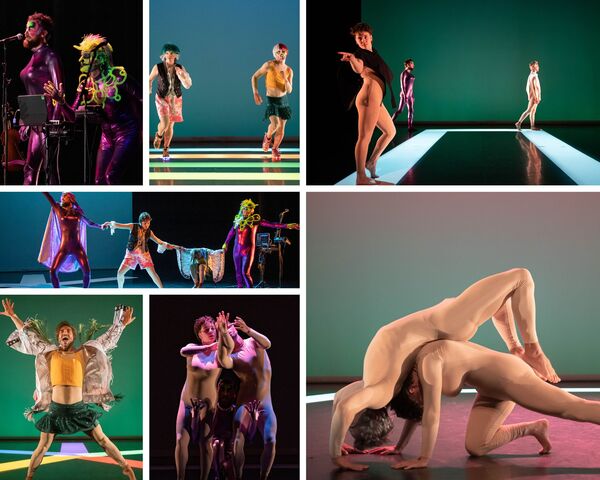ANIMA: No, but like, what!
Posted By Dieter Loquen on 24/10/2022
With his new choreographic creation, Christian Ubl tackles the question that is so topical among our Z and Alpha generations: self-confidence, self-affirmation. ANIMA, which mischievously eyes Japanese culture, far from the political or community manifesto, questions the notion of gender and the non-binarities between man and woman. Interview with its creator.
ANIMA is part of your cycle which questions identity transformation and follows La Cinquième saison. How does ANIMA echo your previous 2021 creation?
It echoes the question of order and disorder in relation to collective memory, what is masculine or feminine and what danced incarnation is readable on the bodies of the performers. In both parts, it was the inversion of the world or the blurred border of an established or binary framework that interested me. In one Lent and Carnival and in the other binary versus non-binary. There are also other points in common: the live music and singing present in both parts, the scenic space treated in a very graphic way, but in a complementary opposition, white in La Cinquième saison and black in Anima. The sliced and evolving costumes are another echo of the treatment. The body is musical and physical and the masks are present in both opuses.
ANIMA is a play for young audiences. The second you sign after H&G from the Brothers Grimm’s Hansel and Gretel tale. Here, the theme is much more contemporary. It would even lend itself to controversy. What research did you do for this piece?
To start, everyone (the performers and myself) brought their reference books, stories and testimonies found on the web, but also shared very personal stories and testimonies related to our journeys. We collected masculine or feminine gestures and energies and confronted them with the body and its ability to embody them. I wanted to create a mini-repertoire of our gendered performative gestures. How the body has learned to embody them and how we use this language.
And how to embody on set this “sometimes confused and complex journey of a teenager who discovers his singularity”, this new era that the Millennial, Z and Alpha generations are embarking on?
This new generation is necessarily influenced by technological advances and their presence in everyday life (computer, video games, metaverse space, the creation of one’s own avatar, etc.). For ANIMA we approached the idea of inventing a fluid gender avatar. By drawing from the manga universe, we created fictional characters with fluid gender identities and thus underlined the point. ANIMA is aimed at young people to create an exchange through dance and see how they approach binary codes, but also the freedom they take with these same codes.
We imagine a whole mediation work to come with young audiences and schools. What will be its content? Did you also meet this young generation before the play to learn from them?
Indeed, the work of mediation is essential. At the start, we had the ambition, as part of my residency at the 2PEC in the city of Istres, to associate college classes. The periods of rehearsals were seated between November and April 22; with the restrictions due to the Covid the photo and dance project “self-confidence” could never start. Finally, we had to modify our approach, by carrying out within the team a questionnaire that we proposed to teenagers in our entourage (circle of friends, acquaintance); it allowed us to collect answers or impressions.

Photos par Nicolas Martinez
We produced a complete educational file, then thought about the structures that could seize the opportunity to raise awareness, because it is indeed one’s own place in society and the treatment of differences that must be questioned through ANIMA.
ANIMA wants to be polymorphic in its content, writing and influence. However, one influence is more significant than others: Japanese culture. How did she inspire you?
A first stage of research was to be done in Japan, but with the Covid period, this projection has also gradually moved away. Instead, we searched the internet for references or articles that could enrich our work. The question of the Japanese mask and make-up, already present in the first part of this diptych, are subjects that I wanted to dig into. We were inspired by kabuki makeup to make masks made by Fabrice Cattalano with a 3D pen. The word “kabuki” comes from the verb “kabuku”, which can mean “to act strangely”. The confusion and discrepancy in their representation of the genre, but also the question of the norm or the framework in relation to the expected or preconceived images.
The musical score is by Fabrice Cattalano, with whom you have had a nice partnership since 2006. How did he think up the music of ANIMA (which also gives pride of place to singing with the lyrical artist Mathieu Jedrazak)?
Upstream, for inspiration, he listened to manga credits, songs for children that talk about gender and differences. He has built up a library of sound materials: sounds that are more feminine and others that are masculine according to the codes of society. Then he read testimonies on the gender issue. What inspired him the pop song Cravate et make-up sung on the set with Mathieu. With Mathieu Jedrazak, we worked on the score of Oh solitude by Henri Purcell with a sung version and an electronic instrumental version. Then the musical score was built with the choreographic score. We went through a lot of discussions and improvisations at the beginning, until the final score.
Your artistic approach called “The world of the body and the body of the world” questions the “identities & origins” and is designed to echo the multiple and complex realities of today’s world and its problems, massive and constant mutations. Does this mean that after ANIMA, you will propose another volume to your cycle on identity transformation?
The next field of research focuses on the butterfly effect and the transformation of a decision or an objective by repercussion or consequence. The identity of the first idea is therefore modified and becomes a new identity, a different trajectory, an echo, a chain reaction…
Thanks to Christian Ubl for his time and answers.
